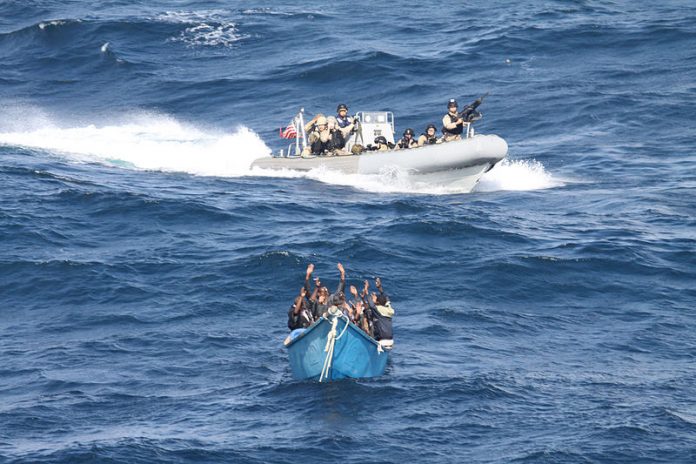
Youssef. M, an eighteen-year-old facing trial in Germany, revealed that he earned $2-3 per day as a night watchman. In 2010, he was offered $500 to pilot a ship, which he later realized was headed to hijack a German cargo. Unfortunately, it was too late for him to react.
Maritime piracy is associated with acts of depredation, violence, rapes, and detentions on the passenger of a private ship. It drains around $7-18 billion for the economy at large. Since 1995, Somalia and West African Coast alone account for forty-six percent of pirate attacks around the world.
After the Tsunami in 2005, when the Somali economy was still struggling to get up, it witnessed toxic dumping in its territorial sea. Soon, the youth took up arms for the protection of the coast and switched into an organized crime, where even children were roped in and piracy was portrayed as a lucrative trade.
The socio-cultural, economic and political factors
Many factors contribute to the escalation of a well-planned piracy endeavor. High levels of poverty, unemployment, long strained political conflicts, and even recurring natural disasters are the prominent backers. Being a country where the average income is $600 a year, the pirates can gain up to thousands of dollars just by plundering one cargo or a ship.
Here, the kingpins are the key figures who approach the recruiters for performing the piracy acts. Children are lured between eleven to seventeen years to assist in rewarding missions. The already low rate of literacy and schooling options keep the children engaged in earning through ‘easy‘ means.
Inhabiting an environment where every third child is associated with piracy leaves the peer with very few options. They are conditioned in such a manner that recruiters make an offer they can’t refuse.
Piracy prosecution through age
The place of prosecution of the apprehended children has always been a bone of contention among the nations. The former UN Special Representative of the Secretary-General, on Child and Armed conflict, Ms. Radhika Coomaraswamy states that, first, there has to be a distinction between trying an adult pirate with a juvenile one. Second, she opined that it is better to integrate children back with their families.
According to the International Covenant on Civil and Political Rights (CCPR), Article 10 states that juveniles shall be imprisoned separately from adults for speedy trials. However, there is no consensus on the upper limit on the age and many a times international and domestic courts prosecute children committing acts of piracy through self-created MACR (Minimum Age of Criminal Responsibility).
To carve out a clear distinction between an adult and a juvenile, countries like India, Germany, and Spain opt for forensic testing to determine the age. In many times the children do not even know their real age and, arbitrariness in setting the detention period comes forth, creating bizarre cases.
Abdu Willy was detained in Spain for marine piracy, where forensic reports reflected him as an adult. The Spanish court considered the following factors — height, weight, clavicle bone, and sentenced him for 439 years.
The role of civil societies
In May 2011, The Somali Civil Society raised its voice in the United Nations Security Council for the unheard voices of the civilians that are entangled in a thick web of humanitarian crises, piracy, anarchy, and gender violence.
It demanded the enhancement of AMISOM’s mandate (African Union Mission to Somalia) along with resources and political support so that human rights can be accepted as a priority. A call was made to end illegal fishing and toxic dumping at the Somalian coast so that rural economies can flourish at their own pace.
Another relevant request was that of creating a Human Rights Commission for Somalia. That would make the extremist groups and piracy gangs accountable for any violation. It was highlighted that if women and elders of the clans are engaged in implementing an infrastructure project, it will give them a sense of acknowledgment.
Fortunately, The United Nations heard the voices, and UNSOM (United Nations Assistance Mission in Somaliland) was established on June 03, 2013 by UNSCR 2102. Training and workshops were conducted to highlight the trauma a child soldier goes through and the impact of armed rebellions on society at large.
A friendly and fruitful manner of tackling ‘almost-ready-child-soldiers’ is to provide them with formal military training along with proper education for recruiting them in the army when they come of age.
Way Forward
Children who end up being pirates are the ones who saw piracy as an everyday affair in their neighborhood. The first step should be to eradicate this normalcy by solely providing them with education institutes. Engaging them in infrastructure creation on the condition of attending informal schools can yield some positive results. Rather than exploiting excellent divers for piracy purposes, it is crucial to encourage them for international sports events.
Further, such a strong network cannot function without money and muscle power involved. Politicians, big business houses, and even religious leaders keep mum just because they have a share in the act of depredation.
The United Nations and other civil societies may work day and night for the betterment of the Somali citizens, but unless the state acknowledges the ground reality and work with the affected ones, nothing can be resolved.
Hence a favorable environment is very much required for the children to envisage a new journey away from trauma, fear, ignorance, and quick material gains, which can only be achieved if the State, citizens, and civil societies go hand in hand.
The views and opinions expressed in this article are those of the author.

The author holds a B. A in Spanish Language and literature from Jawaharlal Nehru University and is currently pursuing an M.A in Conflict Analysis and Peacebuilding from Jamia Millia Islamia.

